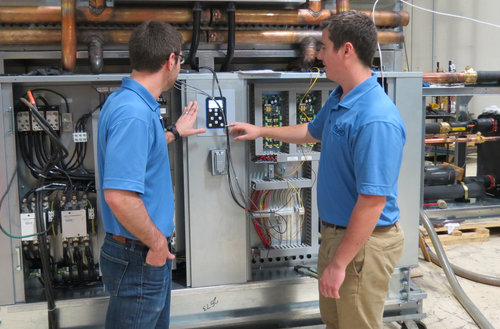
Refrigerant leaks can wreak havoc on industrial chillers, reducing the load capacity and performance so much that your equipment may lose the essential cooling required to run smoothly. Refrigerant leaks are prevalent among older chillers, which are prone to losing 2-15% of refrigerant annually. In comparison, high-efficiency systems expertly manufactured and equipped with specialized pressure vessels and seals can drop the loss rate to as low as 0.1% per year.
This post will explain how we ensure industrial chillers are primed for optimal performance throughout their useful life. We’ll also provide a few pointers for detecting signs of refrigerant leaks and how you can keep your chiller going strong.
4 Industrial chiller manufacturing steps to prevent refrigerant leaks
The easiest way to avoid refrigerant leak hassles is to choose an industrial chiller manufacturer that goes the extra mile to catch it before the system hits your facility floor.
The following are four critical steps we follow during the manufacturing process to stop leaks in their tracks:
1. System brazing
The first step we use in manufacturing to prevent refrigerant leaks in industrial chillers is to braze the system together, tying all copper joints together with copper and 15% silver solder when connecting the lines to the main components. This process reinforces leak-prone chiller parts to keep the refrigerant from seeping out.
2. Nitrogen leak detection
Now, it’s time for the first check. To perform this leak test, we build industrial chillers with nitrogen up to 150 PSI and fill them until the systems are full. After the nitrogen sits and settles, we record the pressure and let them maintain that pressure for an hour to ensure the nitrogen has not leaked.
3. Helium leak detection
The third step we follow is to check for smaller leaks using the same process as the nitrogen, but we use helium instead. Helium is a lighter gas with a smaller atomic size than nitrogen, allowing us to find even the smallest holes. We use the industry-leading Inficon Helium Sniffer Leak Detector tool to identify the lowest detectable leak rate of 1 x 10 -7 mbars l/s – a very tiny leak! Using this handheld device with a connected hose, we “sniff“ all over an industrial chiller’s surface. A car alarm-like sound will signal a leak. If we’ve sniffed the whole system with this advanced tool and no alarm sounds, we are confident that there is no detectable refrigerant leak.
4. Final leak detection
The fourth leak detection step we follow during manufacturing starts with deep vacuuming at 500 microns to remove moisture, air, and non-condensable gasses like nitrogen from our industrial chillers. Then, we charge and run the systems for 1-2 hours to mimic the stress and strain of their future application environment. That’s when we deploy the final check for leaks using the Inficon Refrigerant Leak Detector, a wand-like device that provides peace of mind that our systems are leak-free.
Not every manufacturer follows this many leak detection steps to ensure their industrial chillers are at peak performance from the start. If leak prevention is important to you, it’s worth asking about the manufacturing process before investing in a system.
So far, we’ve identified our leak detection processes and tools during the manufacturing process. But what happens if there’s a leak after the system is installed? Read on to discover the top five signs you might have a refrigerant leak – and what to do about it.
5 Signs of a refrigerant leak
Let’s say your system has been out in the field for a few years. Here are a few signs to look for during your routine maintenance checks that may indicate a refrigerant leak:
1. The system cannot keep up with load capacity, reducing its performance
2. Lower suction and lower discharge pressures than usual
3. Potential fan cycling due to low discharge pressure
4. High evaporator superheat
5. Compressor pulls lower amperage than usual
If you notice these signs, be sure to contact an industrial chiller service technician to check for a leak. During this service call, the technician may use a refrigerant leak detector equipped with an alarm. They may also use an old-school soap and water leak detection method that produces bubbles on any joint with a refrigerant leak.
The best way to prevent a refrigerant leak in industrial chillers is to choose a manufacturer committed to deploying added layers of protection against leaks before the system even arrives at your facility. Our comprehensive four-step manufacturing process is our way of providing the peace of mind Drake industrial chillers are known for. To learn more about the manufacturing process for our robust line of custom-ready industrial chillers for brewery, dairy, food processing, medical, and industrial facilities throughout the U.S., reach out to our seasoned experts today.

